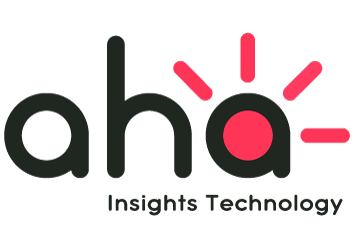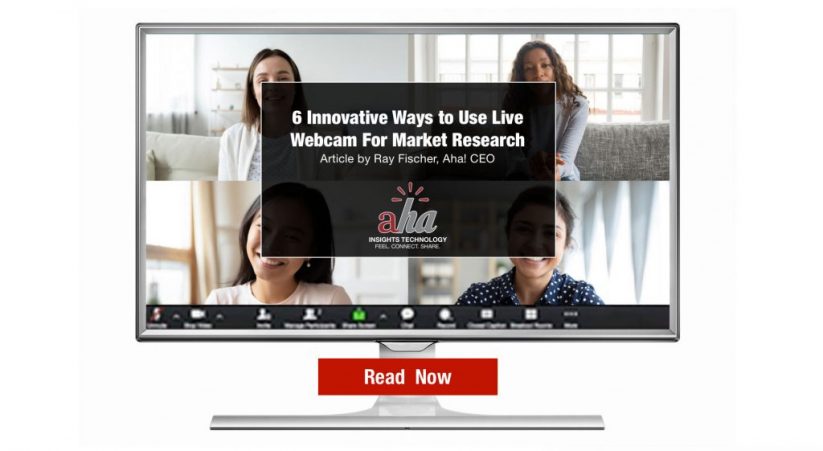6 Innovative Ways to Use Live Webcam in Today’s Market Research World
Hard to believe it has been almost two years since we introduced Aha! Live Conversations™, the first-ever integration of Zoom’s Unified Communication Platform, as part of our comprehensive suite of market research tools. The integrated platform – featuring video, voice, content sharing, and backroom chat technologies – gives market researchers and corporations the ability to conduct live webcam conversations with respondents to gain a deeper understanding of the emotions, attitudes, and behaviors that drive buying decisions and product usage. The impact of Covid-19 on market research activities has only accelerated the use of live webcam as a tool to connect with customers and prospects in a time when traveling from market to market to conduct F2F focus groups, IDIs and in-home ethnographies have been severely restricted. This acceleration has spurred several creative and innovative uses of webcams, as well as a few lessons on how not to use this technology for market research.
Here are six great approaches for incorporating our live webcam and mobile technology to augment your qualitative research:
Live IDIs: Asynchronous online studies followed by Live Webcam IDIs is a powerful hybrid combination of the asynchronous and live methodologies. If the budget allows, it is highly beneficial to select 8-10 of your star respondents from your asynchronous phase, then schedule deep-dive webcam interviews for 30-60 minutes. This allows you to cherry pick the most insightful respondents and discuss anything that may have come up in the study that you want to understand better. You can further explore insightful themes that may have emerged or simply get more context around the findings that you are planning to make the focal point of your report.
Stand-Alone Live Groups: While we initially launched Aha! Live Conversations as an 1:1 add-on to asynchronous activities, due to market demand from key customers we swiftly adapted to doing webcam sessions with 2-4 people regardless of whether there was an asynchronous component or not. While pre-work is highly recommended, a simple 20-30 minute on-platform homework assignment before the sessions truly supercharges groups. Note, we highly recommend keeping your sessions small-ish as we believe that more than 3-4 respondents in an online group is a bit more challenging due to time constraints and respondent distractions.
Mobile Missions: Live, face-to-face conversations allow researchers the opportunity to ride shotgun with their customers as they navigate decision-making processes in real-time at places where they live, work, play, and spend. For example, customers can be sent to the grocery to shop for cereal. When they get to the store, they simply initiate the video session and have a conversation describing what is in front of them and answer any guided and impromptu questions the researcher on the other end of the call may have. This is a much more efficient way to do a shop-along exercise delivering in-the-moment insights at a fraction of the cost and time.
Concept Testing/Web-usability: Live, recorded interactions with respondents as they look at ideas or websites allows researchers to get a deeper level of understanding regarding their in-the-moment thoughts, feelings, and actions as they are exposed to new ideas. The beauty of this live approach is that respondents can narrate their thoughts and feelings out loud and give the researcher the opportunity to probe along the way, asking questions as the respondent navigates the concept or website. While asynchronous approaches are great, this live, shared discussion gives greater freedom and creativity to the researcher resulting in more robust insight into the mind of the respondent.
Digital In-Home Ethnography: In-home ethnographies have come a long way since researchers actually had to visit a respondent’s home in a staged and somewhat artificial environment (think moderator, videographer and 2-3 clients descending upon a respondent’s home). Digital Ethnographies are very popular these days. By adding the live element of a shared video chat, you can get real-time usage feedback in an up-close and personal way. Often aided by a selfie-stick, respondents give tours of their homes, showing us areas and items that are relevant to the study topic. They demonstrate behaviors for us. Share thoughts and feelings. And, generally, give us much of what we’d get in a live, in-person ethnographic interview. Client teams can observe everything that happens, just like in an in-person ethnographic interview, without the intrusion of a team following the respondent around.
Customer Experience Studies: Live webcam has become a highly effective tool for corporate researchers and marketers to get closer to the customers with whom they are creating long-term relationships. In longitudinal CX studies respondents make quant and qual contributions along with journaling and diary entries to give deep insights into their journey. There is nothing more personal than jumping on a live webcam video call and connecting with people face-to-face. This F2F interaction actually builds real empathy towards consumers and gives the insights team (and other employees) an opportunity to explore more freely through a legitimate friendship built over the course of time. Aha! Live Conversations has the functionality that allows spontaneous live text chat with respondents to catch up or schedule a live session.
These examples are just the tip of the iceberg of how Live Webcam and Mobile Insights Technologies are revolutionizing market research.
Aha! Live Conversations integrates the Zoom platform seamlessly. Respondent recruiting and scheduling, tech checks and onboarding support, incentive check fulfillment, automated or human transcripts and, perhaps most importantly, both asynchronous exercises and live sessions all in one place. No need to juggle multiple logins and platforms. Plus, our Zoom integration provides an added layer of privacy and security that automatically anonymizes users’ personal data and identities.
If you would like to understand more about how our online research platform can help you and your team gain deeper insights on your next project, let’s talk.





